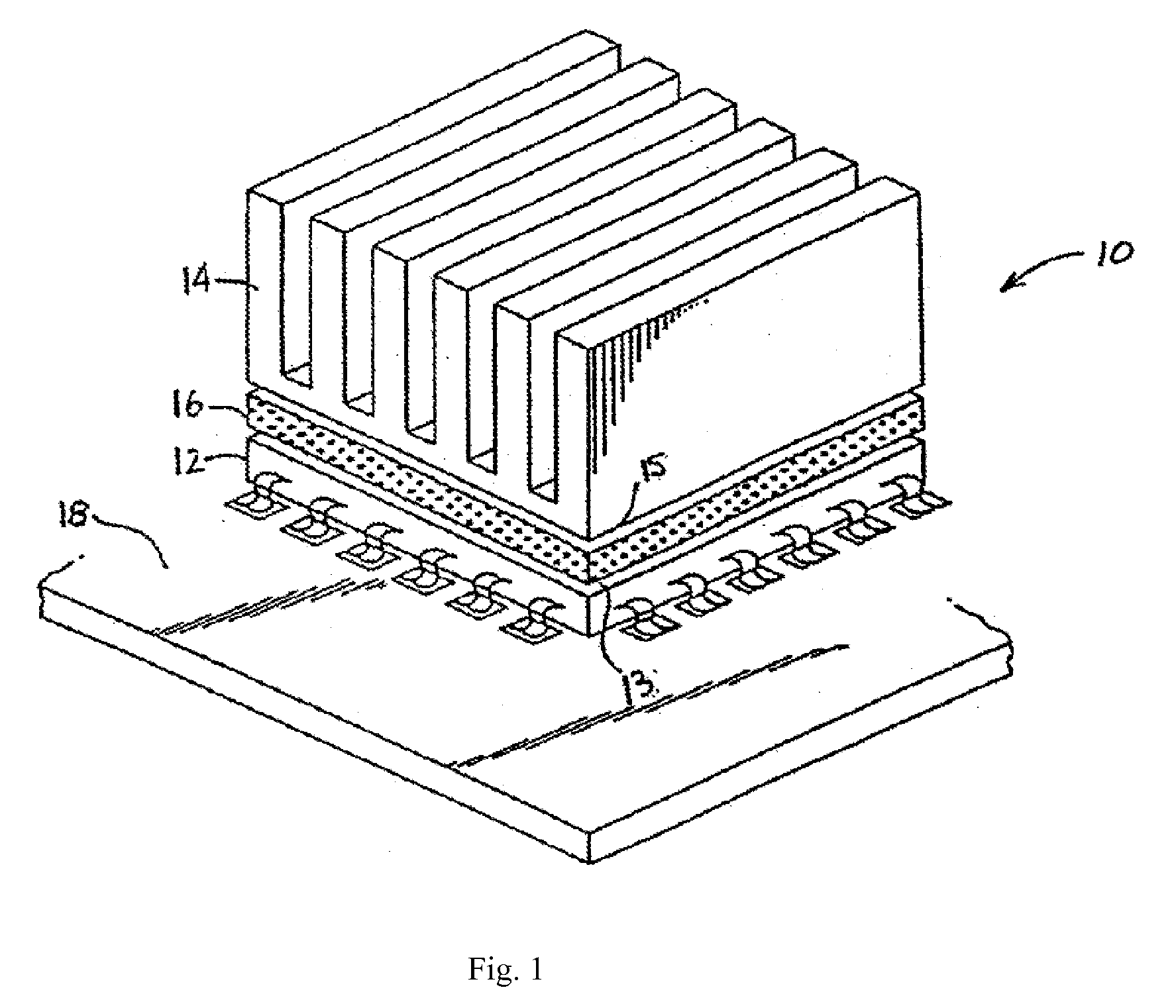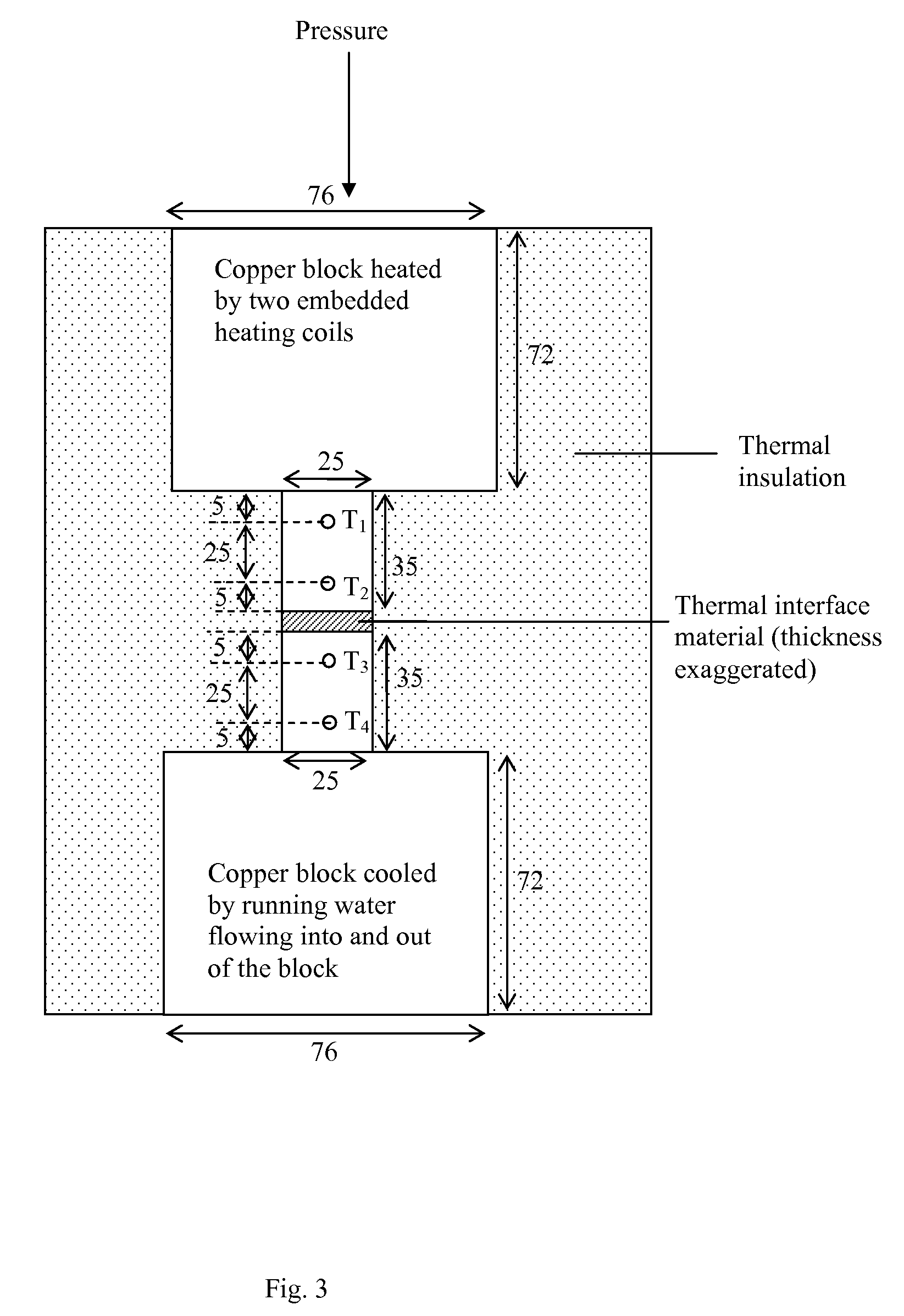Conformable interface materials for improving thermal contacts
a technology of interface materials and thermal contacts, applied in the field of conformable interface materials for improving thermal contacts, can solve the problems of carbon black, low thermal conductivity of ideal graphite, and difficulty in making workable pastes that contain fibers (discontinuous) instead of particles, and achieve the effect of exceptional effectiveness and fine scal
- Summary
- Abstract
- Description
- Claims
- Application Information
AI Technical Summary
Benefits of technology
Problems solved by technology
Method used
Image
Examples
example 1
Preparation of Paste Formulations
[0090] This example pertains to the preparation of paste formulations. The pastes include fluidic and thixotropic ones. They include pastes with carbon black as the thermally conductive solid component, as well as sheets with a thermal paste coating on each of the two opposite surfaces of the sheet. They also include combinations of carbon black paste and silver paste and of carbon black paste and ceramic paste.
[0091] The polyethylene glycol, HO(CH2CH2O)11H, (“PEG”) used as an organic vehicle in a fluidic paste was PEG 400 (EM Science, Gibbstown, N.J.). It had a molecular weight (i.e., average molecular weight) of 400 amu. The molecular weight should not exceed 1,000 amu, as the viscosity of polyethylene glycol increases with increasing molecular weight and a high viscosity tends to be associated with low conformability. The polyethylene glycol used was a liquid at room temperature and optionally contained ethyl cellulose (Sigma Chemical Co., St. L...
example 2
Thermal Contact Conductance Measurement by Transient Method
[0102] As depicted in FIG. 2, a layer of a thermal paste (or thermal interface material or solder) 16 was sandwiched between the flat surfaces of two copper disks 20,22 (both surfaces of each disk having been mechanically polished by using either 0.05 or 15 μm alumina particles), which had diameter 12.6 mm and thickness of 1.16 mm for one disk and 1.10 mm for the other disk. The thermal contact conductance between two copper disks with and without layer 16 was measured using the transient laser flash method. Xu, Luo and Chung, J. Electron. Pkg. 124:188-191 (2002); Xu, Luo and Chung, J. Electron. Pkg. 122:128-131 (2000); Parker et al., J. Appl. Phys. 32:1679-1683 (1961); Inoue et al., Yosetsu Gakkai Ronbunshu / Quarterly J. Jap. Welding Soc., 6:130-134 (1988), which are hereby incorporated by reference in their entirety.
[0103] The pressure on the sandwich (i.e., copper surfaces sandwiching a thermal interface material) was co...
example 3
Thermal Contact Conductance Measurement by Steady-State Method
[0109] This example pertains to testing the effectiveness of various thermal interface materials by measuring the thermal contact conductance across copper surfaces using a steady-state method. The use of both the transient method of Example 2 and the steady-state method of this example provides further support for the validity of the conductance results reported here.
[0110] In the steady-state method, various thermal interface materials were sandwiched between the 1×1 inch (25×25 mm) proximate surfaces of two copper blocks (both 1×1 inch surfaces of each block having a controlled degree of roughness). Each copper block had a height of 35 mm.
[0111] The thermal contact conductance between two 1×1 inch (25×25 mm) copper blocks with a thermal interface material between them was measured using the guarded hot plate method, which is a steady-state method of heat flux measurement (ASTM Method D5470). The heat in this test wa...
PUM
| Property | Measurement | Unit |
|---|---|---|
| thickness | aaaaa | aaaaa |
| pressure | aaaaa | aaaaa |
| particle size | aaaaa | aaaaa |
Abstract
Description
Claims
Application Information
 Login to View More
Login to View More - R&D
- Intellectual Property
- Life Sciences
- Materials
- Tech Scout
- Unparalleled Data Quality
- Higher Quality Content
- 60% Fewer Hallucinations
Browse by: Latest US Patents, China's latest patents, Technical Efficacy Thesaurus, Application Domain, Technology Topic, Popular Technical Reports.
© 2025 PatSnap. All rights reserved.Legal|Privacy policy|Modern Slavery Act Transparency Statement|Sitemap|About US| Contact US: help@patsnap.com



